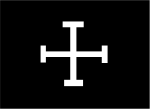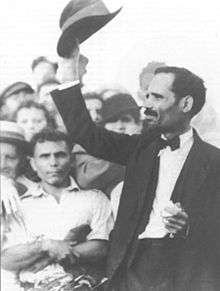Jayuya Uprising
| Jayuya Uprising | |||||||
|---|---|---|---|---|---|---|---|
 Puerto Rican flag removed by a member of the National Guard after the 1950 Jayuya Uprising | |||||||
| |||||||
| Belligerents | |||||||
|
|
| ||||||
| Commanders and leaders | |||||||
|
|
| ||||||
| Casualties and losses | |||||||
| 3 Nationalists dead | 6 police officers injured | ||||||
| Part of a series on the |
| Puerto Rican Nationalist Party |
|---|
 Flag of the Puerto Rican Nationalist Party |
|
Nationalist leaders
|
The Jayuya Uprising, also known as the Jayuya Revolt or El Grito de Jayuya, was a Nationalist revolt that took place on October 30, 1950, in the town of Jayuya, Puerto Rico. The revolt, led by Blanca Canales, was one of the multiple revolts that occurred throughout Puerto Rico on that day against the Puerto Rican government supported by the United States. The Nationalists considered the US to be a colonial power.
Events leading to the revolt
The Puerto Rican Nationalist Party was formed in 1922 to work for Puerto Rican Independence. By 1930 Pedro Albizu Campos, a lawyer who was the first Puerto Rican graduate from Harvard Law School, was elected president of the party.

In the 1930s, the United States-appointed governor of Puerto Rico, Blanton Winship, and the police colonel, a former U.S. Army Colonel named Elisha Francis Riggs, applied harsh repressive measures against the Nationalist Party.[1] In 1936, Albizu Campos and the leaders of the party were arrested and jailed at the La Princesa prison in San Juan, and later sent to the Federal prison in Atlanta. On March 21, 1937, the police opened fire on the crowd at a Nationalist parade, killing 19 people in what came to be known as the Ponce Massacre. Albizu Campos returned to Puerto Rico on December 15, 1947, after spending ten years in prison.
In 1948, the legislature, controlled by the Partido Popular Democratico de Puerto Rico and presided over by Luis Muñoz Marín, approved a bill to suppress government opposition.[2] This bill, also known as Ley de la Mordaza (Gag Law) and Law 53, received the approval of the legislature on May 21, 1948. The bill was signed into law by U.S.-appointed governor Jesús T. Piñero on June 10, 1948. It became known as Ley 53 (Law 53).[3]
Under this new law it would be a crime to print, publish, sell, or exhibit any material intended to paralyze or destroy the insular government; or to organize any society, group or assembly of people with a similar destructive intent. Anyone accused and found guilty of disobeying the law could be sentenced to ten years imprisonment, a fine of $10,000 dollars (U.S.), or both.
According to Dr. Leopoldo Figueroa, a member of the Partido Estadista Puertorriqueño (Puerto Rican Statehood Party) and the only member of the Puerto Rico House of Representatives who was not a member of the PPD,[4] the law was repressive and in violation of the First Amendment of the US Constitution guaranteeing Freedom of Speech. As such, the Law was seen as an assault on the civil rights of every Puerto Rican.[5]
On June 21, 1948, Albizu Campos gave a speech in the town of Manatí that explained how this Gag Law violated the First Amendment of the U.S. Constitution. Nationalists from all over the island had gathered to hear Albizu Campos's speech and to prevent the police from arresting him.
Uprising
From 1949 to 1950, the Nationalists in the island planned and prepared an armed revolution. The revolution was to take place in 1952, on the date the United States Congress was to officially approve the Estado Libre Associado ("Free Associated State") political status for Puerto Rico.
Albizu Campos called for an armed revolution because he considered the "new political status" to be a colonial farce. Campos picked the town of Jayuya as the headquarters of the revolution because of its location and because weapons were stored in the home of Blanca Canales.
On October 26, 1950, Albizu Campos was holding a meeting in Fajardo, when he received word that his house in San Juan was surrounded by police waiting to arrest him. He was told that the police had already arrested other Nationalist leaders. He escaped from Fajardo and ordered the revolution to start. On October 27, the police in the town of Peñuelas, intercepted and fired upon a caravan of Nationalists, killing four.
On October 30, the Nationalists staged uprisings in the towns of Ponce, Mayagüez, Naranjito, Arecibo, Utuado (Utuado Uprising), San Juan (San Juan Nationalist revolt), and Jayuya.

In the pre-dawn hours of October 29, the Insular Police surrounded the house of the mother of Melitón Muñiz Santos, president of the Peñuelas Nationalist Party, in Barrio Macaná, under the pretext that Muñiz was storing weapons for the Nationalist Revolt. Without warning, the police fired on the house and a gunfight ensued. Two Nationalists were killed and six police officers were wounded.[6] Nationalists Meliton Muñoz Santos, Roberto Jaume Rodriguez, Estanislao Lugo Santiago, Marcelino Turell, William Gutirrez and Marcelino Berrios were arrested and accused of participating in an ambush against the local Insular Police.[6]
Members of the Nationalist Party had stored weapons in Canales' house in Jayuya. Canales and the other leaders, including her cousin Elio Torresola and Carlos Irizarry, led the armed Nationalists into the town and invaded the police station. Shots were fired, one officer was killed, three were wounded, and the other officers surrendered. The Nationalists cut the telephone lines and burned the U.S. post office. Canales led the group into the town square where, in defiance of the Puerto Rico Gag Law, they raised the Puerto Rican Flag.[7] In the town square, Canales declared Puerto Rico a free Republic. Torresola had a brother, Griselio Torresola, living in New York City, who was outraged by the attacks.
.jpg)
The governor, Luis Muñoz Marin, declared martial law. The Puerto Rico National Guard, under the command of the Puerto Rico Adjutant General, Major General Luis R. Esteves,[8] used P-47 Thunderbolt bomber planes, land-based artillery, mortar fire, and grenades to attack the town. The planes machine-gunned nearly every rooftop in the town. After the Nationalists were forced to surrender, the Puerto Rican government made mass arrests.
Although an extensive part of Jayuya was destroyed, news of the military action was prevented from spreading outside of Puerto Rico. Instead, the American media reported President Truman saying it was "an incident between Puerto Ricans."[7][9]
Nationalists in New York City as well as Puerto Rico were outraged by the attack. Griselio Torresola and Oscar Collazo, among Nationalists in the city, made a quick plan to assassinate the U.S. President, Harry S. Truman. He was reported as staying at Blair House while the living quarters of the White House were under renovation. After traveling south by train, on November 1, 1950, they attacked guards at the Blair House, seeking to gain entry. Torresola and White House police officer Leslie Coffelt were killed in the attempt; Collazo and two American officers were wounded.
Aftermath
|
|
The top leaders of the Nationalist party were arrested, including Albizu Campos and Blanca Canales, and sent to jail to serve long prison terms. Oscar Collazo was convicted of murder in the US and sentenced to death. U.S. President Truman commuted his sentence to life. In 1979 President Carter commuted Collazo's sentence to time served. The Nationalist was released and returned to Puerto Rico. The city of Jayuya converted the Blanca Canales home into a historical museum.
The last major attempt by the Puerto Rican Nationalist Party to draw world attention to Puerto Rico's colonial situation occurred on March 1, 1954, when nationalist leader Lolita Lebrón, together with fellow nationalists Rafael Cancel Miranda, Irving Flores and Andrés Figueroa Cordero, attacked members of the United States House of Representatives, shooting from the gallery and wounding several members. Lebrón and her comrades were charged with attempted murder and other crimes.[10]
Gallery
| Jayuya Uprising Monuments | ||||||||
|---|---|---|---|---|---|---|---|---|
|
Further reading
- Nelson Antonio Denis, War Against All Puerto Ricans: Revolution and Terror in America’s Colony, Author: Nation Books (April 7, 2015); ISBN 978-1568585017.
See also
- Puerto Rican Nationalist Party
- Ducoudray Holstein Expedition
- Grito de Lares
- Intentona de Yauco
- Río Piedras massacre
- Ponce Massacre
- Puerto Rican Nationalist Party Revolts of the 1950s
- Utuado Uprising
- San Juan Nationalist revolt
- Puerto Rican Independence Party
- List of Puerto Ricans
- Truman assassination attempt
References
- ↑ Puerto Rico By Kurt Pitzer, Tara Stevens, page 224, Published by Hunter Publishing, Inc, 2001, ISBN 1-58843-116-9, ISBN 978-1-58843-116-5
- ↑ "La obra jurídica del Profesor David M. Helfeld (1948-2008)'; by: Dr. Carmelo Delgado Cintrón
- ↑ "Puerto Rican History". Topuertorico.org. January 13, 1941. Retrieved November 20, 2011.
- ↑ "Ley Núm. 282 del año 2006"
- ↑ La Gobernación de Jesús T. Piñero y la Guerra Fría
- 1 2 El ataque Nacionalista a La Fortaleza. by Pedro Aponte Vázquez. Page 7. Publicaciones RENÉ. ISBN 978-1-931702-01-0
- 1 2 New York Latino Journal Archived October 21, 2008, at the Wayback Machine.
- ↑ Puerto Rico National Guard
- ↑ "War Against All Puerto Ricans, Revolution and Terror in America's Colony"; Author Nelson Antonio Denis; Page 263; Publisher Nation Books; ISBN 1568585012; ISBN 978-1568585017
- ↑ Ribes Tovar et al., p.132
External links
- Sánchez, Laura N. Pérez (October 3, 2011). "La mismas rutas, el mismo sueño". El Nuevo Dia.
- Photos of the Jayuya Uprising
- Puerto Rico Marks 60th Anniversary of Jayuya Uprising - video report by Democracy Now!
- Nationalist Party of Puerto Rico-FBI files, PR-Secret Files, raw data
